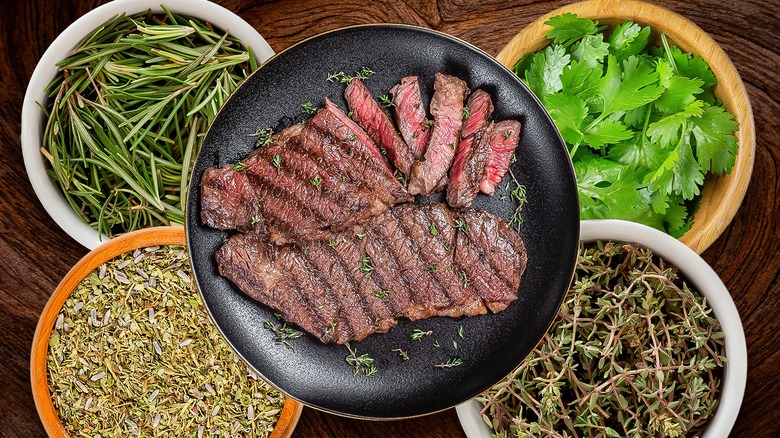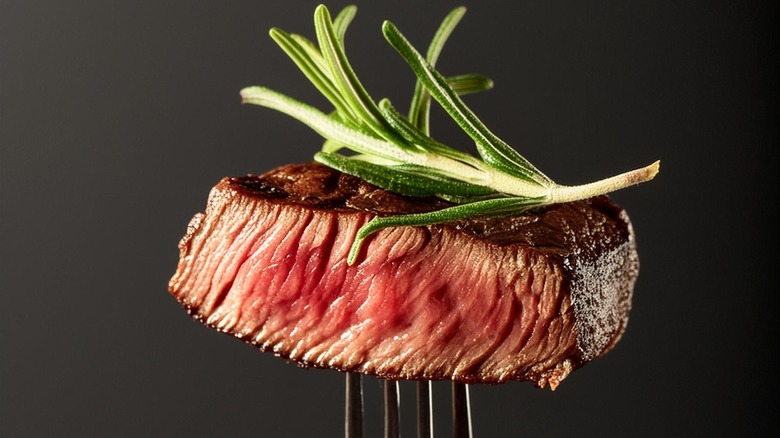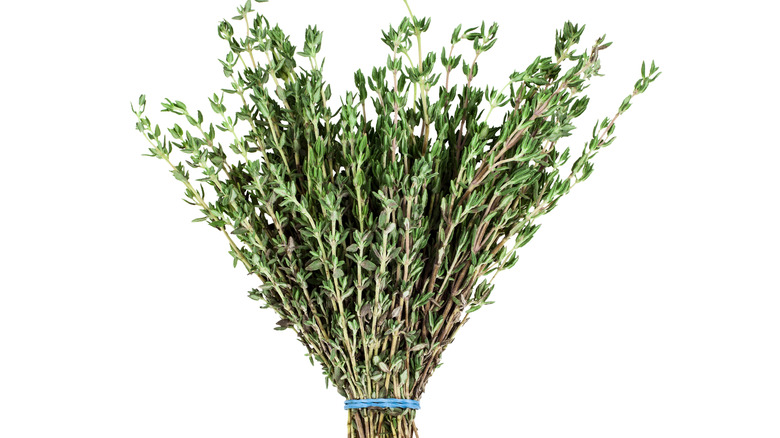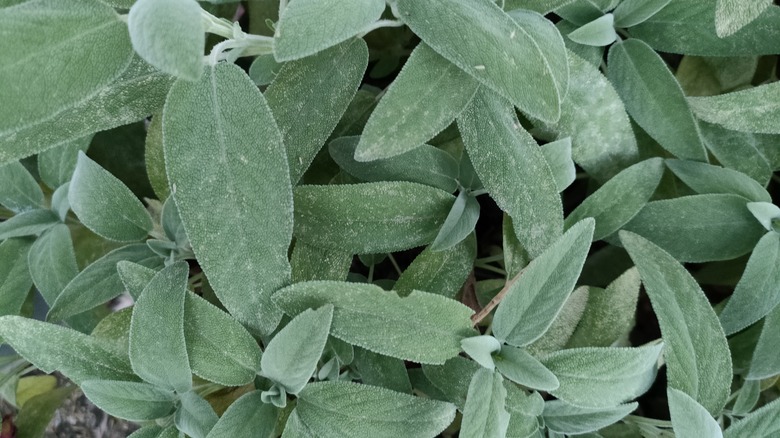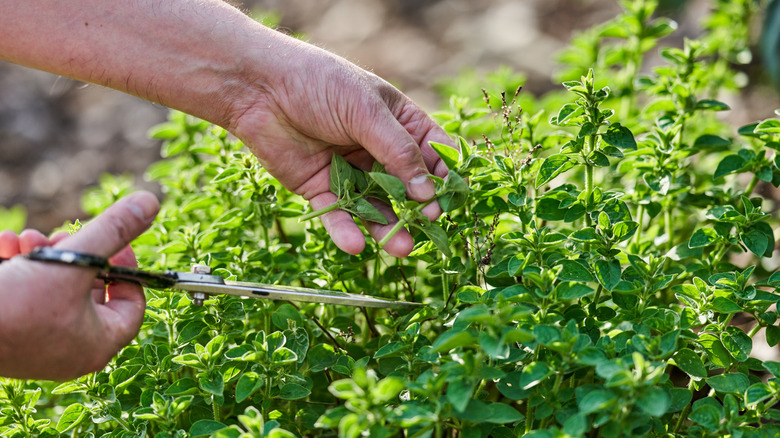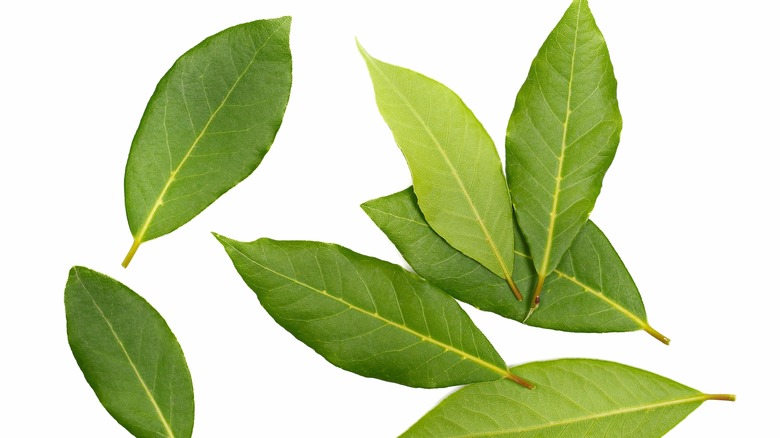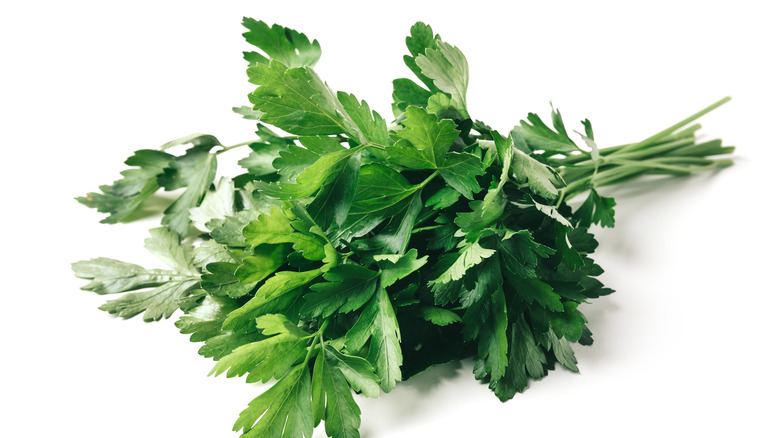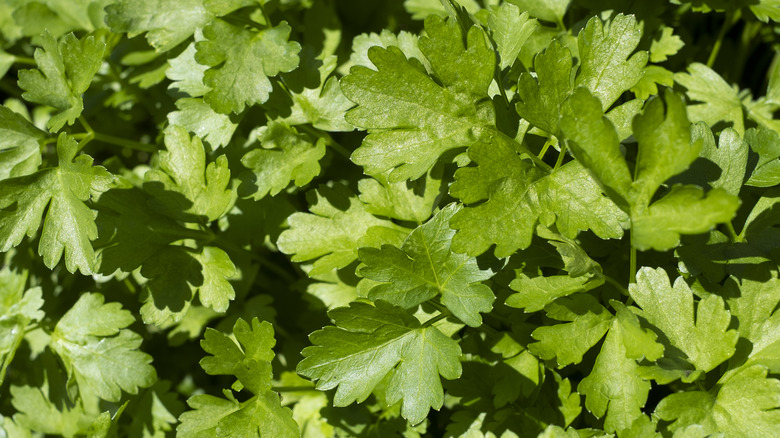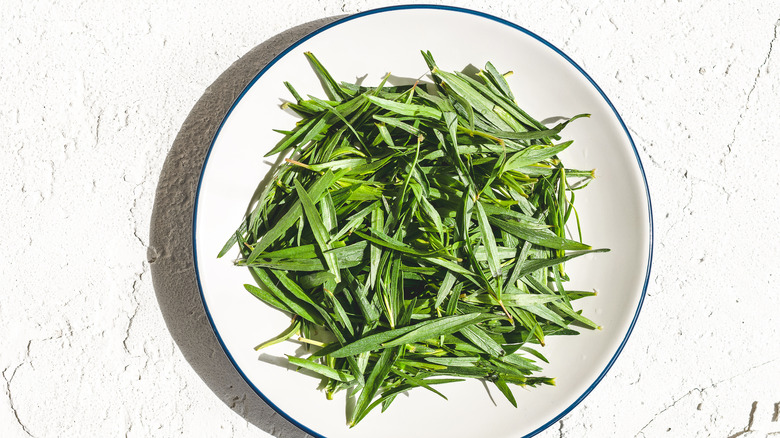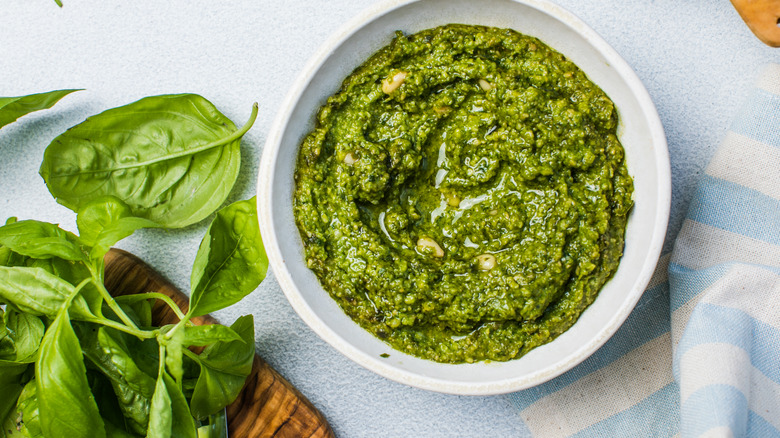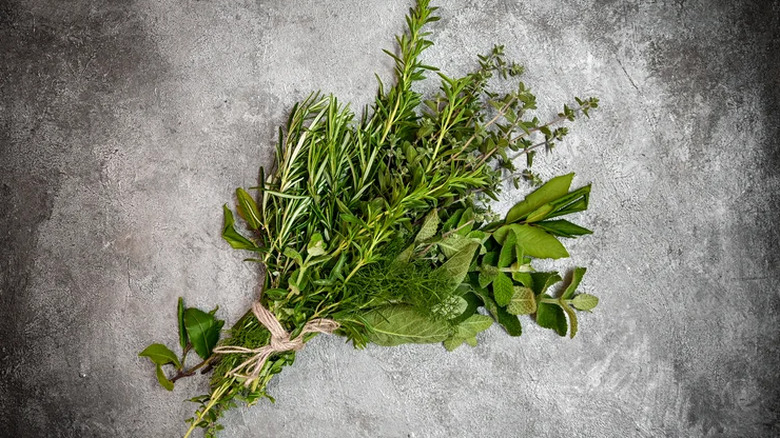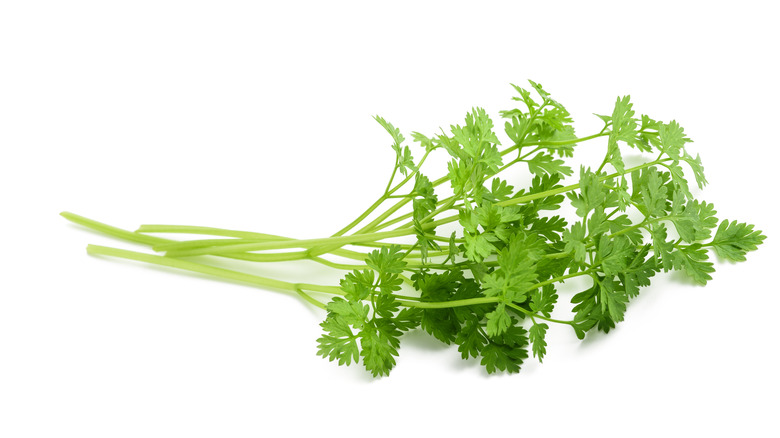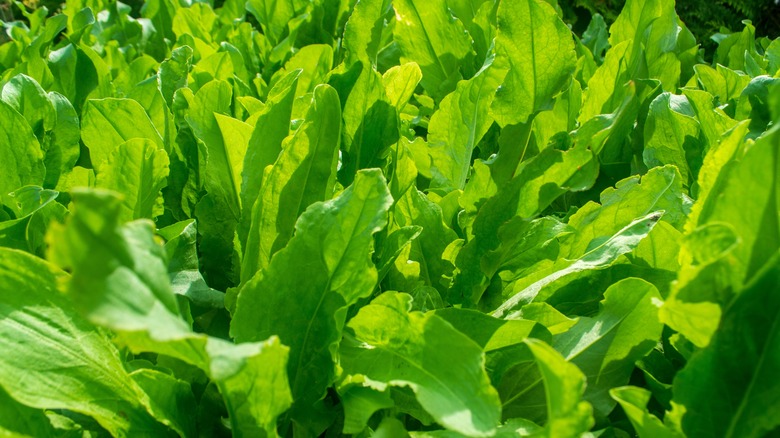12 Fresh Herbs That Will Seriously Elevate Your Steak
Depending on where you lie on the enthusiasm scale, making steak could be an easy dinner or an art form in itself. Cooking steak doesn't need to be complicated, and it doesn't take much to make a great steak taste good. Serious steak lovers might insist that all you need is salt and maybe a little pepper, but there are so many great ways to enhance a steak's flavor that it can be a missed opportunity for a bit more oomph. We're not talking ketchup or barbecue sauce, although I'm not one to yuck anyone's yum, but using fresh herbs can be a glorious way to add some brightness or earthy flavors and elevate your steak without much effort. Plus, when used correctly, they can complement your steak in just the perfect amount without overpowering it.
As a recipe developer, I always keep a variety of fresh herbs on hand as they can make so many dishes instantly better and more sophisticated, using just a handful or so. Fresh herbs are so easy to use, and there are so many that go well with steak that it's not difficult to get it right. With steak, it's not only the type of herb you choose, but also how you prefer it. Depending on the herb, I like to toss them in the cooking oil and let them infuse, or make an herbaceous compound butter with them, or sometimes just add them straight onto your meat for even more tasty goodness. There are many tastes and effects to choose from, depending on the seasonality of the herbs you find where you are. Here are some fresh herbs that will seriously elevate your steak.
Rosemary
When it comes to cooking meat in general, an obvious choice of herb that comes to mind is rosemary. Rosemary is bursting with an earthy, woody flavor that adds so much aroma to meaty dishes. It goes great with roast chicken, lamb, beef, pork, and more. Using rosemary with steak is a no-brainer, and opting for the fresh stuff will make the flavor even more pronounced.
There are also different ways you can add your rosemary. I like to use a whole bunch and brush the steak with it or simply place it on top of the steak as it's cooking. The residual heat from the steak will warm the rosemary and help it release its oils, thus creating a lot of flavor. With rosemary, you don't have to eat the actual herbs to taste it (although you can eat the leaves); in fact, you can discard it after cooking, but it will have left its mark. If you're feeling a bit more extravagant, rosemary is the perfect choice for a compound butter. You can get fancy and try this French steak frites with rosemary compound butter with just a few ingredients (don't worry, it's a lot easier than it sounds). In a bowl, mix some butter, salt, pepper, and rosemary leaves together until well combined. That's it; now you've made compound butter. You can keep it simple or add in other ingredients that you love, too. Then, smear some of that butter on your hot steak and enjoy every bite.
Thyme
Thyme is an herb that I often keep in dry form in my pantry. However, when I met up with some Greek friends to cook together, I found out how delicious it is to use fresh thyme instead. One of the beloved flavors of Greek cooking, thyme is a fresh herb that's used in meat dishes, as well as on bread, cheese, fish, and more. It's sort of an all-purpose herb, making it perfect for elevating your steak. Dried thyme can sometimes become a little bitter, but you won't get that with the fresh herb. Plus, it plays well with other herbs, too, so you can mix it with others. It can be a little finicky to pick the thyme leaves off of the hard stalk, but one trick is to rub two fingers from the top to the bottom of the stalk in the direction that goes against how the leaves are growing. You'll naturally gather the leaves with your fingers as you move them down.
It's especially good to marinate your steak with, as it will perfume your meat before it even gets to the grill or pan. Make a simple olive oil, thyme, salt, pepper, and garlic marinade, and let your steak sit in it for at least 20 minutes to soak it all up. If you want to add a Greek touch, you could also splash in a little vinegar or lemon juice, which will tenderize your steak while rounding out the flavor with a bit of acidity.
Sage
Sage is perhaps underrated in everyday cooking. With its grayish-green leaves and woody stem, sage can be a marvelous flavor enhancer in so many ways, and it pairs really well with meat. An easy way to use sage is to throw it into some warm butter. Sage and butter are a match made in heaven, and you can baste your steak with some of this butter while or after cooking.
An interesting thing about sage that you may or may not know is that it can even be used to add an extra crunch to your steak. Sage is actually a herb that you can fry. In hot oil or butter, sage curls and gets browned, and when taken off at the right moment and drained off any excess liquid, it becomes delightfully crispy. This not only adds a dynamic flavor element but also gives an interesting texture to your food. It's so delicious that you'll want to have a bite of crispy sage with every bite of steak.
Oregano
If you're familiar with Italian flavors, you've definitely come across oregano before. It's often shaken on your pizza at an Italian restaurant, and it adds an herby complexity to food in the best way. Fresh oregano is not as easy to come by as other herbs, but if you manage to get your hands on some, grab it without thinking twice. It is true that fresh oregano is a lot more pungent than dried, but if used in just the right amount, it can be deliciously fragrant. The bright herbaceousness complements the umami notes of the steak.
Fresh oregano is best when it's used to infuse its flavor into food rather than eaten straight, where it can be a bit too strong. Think of infused olive oil or butter or used in a marinade. A marinade is my preferred method, and I use a bunch of whole oregano. No need to remove and chop individual leaves because you're going to remove the whole thing before cooking. It's not only less work but also better for the dish to keep the leaves on the stem. Try this oregano-based traditional Italian marinade for a quick and tender steak.
Bay leaves
There are often jokes online about whether bay leaves actually do anything to your food. Recipes often tell you to add two or three dried bay leaves into your stew, stock, or curry, and the flavor can be so subtle that it's hard to detect. In truth, you might not know the exact taste of bay leaves, but their absence can be felt. If you want to get the best out of bay leaves, it's often best to use them fresh. Fresh bay leaves have a stronger, more pronounced flavor, and you'll definitely be able to detect their unique essence in your food.
With steak, fresh bay leaves can add a more complex element to the taste. As fresh bay leaves have aromas of pepper and pine, they can cut through the fatty, meatiness of steak and create a more full-bodied mouthfeel. Take note that they can turn slightly bitter if cooked too long, so they work best in quick cooking methods, like throwing them in the pan with the steak near the end of cooking or shortly steeped into a steak jus.
Parsely
Parsley is perhaps one of the most used fresh herbs in the U.S., and most people are going to be really familiar with it. It's often also thrown on dishes as a garnish, but this doesn't help it reach its full potential as an ingredient in its own right. Sure, it might not make sense to simply throw some parsley onto steak and call it a day, but it can be a really delicious herb when paired with butter, lemon juice, and garlic.
Mix those ingredients together, and you have a flavor bomb that will elevate most things but go especially well with a grilled protein like fish or steak. Plus, it couldn't be easier to make — just melt some butter and throw in some chopped fresh parsley leaves (remember to pick out the stems which, while edible, can be a little harder to chew), a squeeze of lemon juice, and some chopped fresh garlic cloves. Finish this quick butter sauce off with salt and pepper and you're going to impress yourself with how delicious your cooking is.
You can slather this sauce on your steak on your plate or slice up the steak on a big platter and generously pour the sauce onto it. For extra freshness, throw some extra parsley leaves on top.
Cilantro
Cilantro is a polarizing herb because of a genetic disposition that makes it taste like soap to some people. But to the rest of the population, it can be a real sure way to give anything a lift. Cilantro's flavor is hard to explain, but the slight notes of citrus make it a herb that adds a lot of brightness to foods. While steak might not need much to make it taste great, it's hard to argue that it definitely benefits from a little brightness to bring out its best self. A squeeze of lemon and some fresh cilantro can take a piece of steak to new heights.
In my opinion, the best way to pair cilantro and steak is by making an easy chimichurri. A vibrant green chimichurri dressed on your steak is a beautiful thing. Chimichurri is a great way to make cilantro shine. It's completely customizable, and you can make it your own with whatever you have available, but the basics are fresh herbs, oil, vinegar, and garlic. You can add chiles if you like it spicy, and you can even play around with herbs and use both cilantro and parsley, or add things like mint, basil, and more.
Tarragon
Tarragon is another herb that's so much more flavorful when fresh. It loses some of its perfume when dried and doesn't live up to its full potential. Tarragon is a complex herb that may not be to everyone's taste as it does have a subtle aniseed flavor. But it's not all the way licorice either, and even if you dislike aniseed, you should give it a try. It can bring out the meatiness and sweetness in all kinds of proteins, including fish, chicken, and meat, and can make an excellent companion for steak, especially when added to a sauce. In my experience, French tarragon can be even milder in the aniseed department, so it's a good place to start if you've never had it.
I like to use fresh tarragon in a butter sauce, along with sauteed mushrooms and garlic. These other strong flavor elements help to balance the aniseed taste, and they all come together in a uniform way. It's the perfect herb to use to impress guests and is guaranteed to elevate your steak.
Basil
You may not naturally jump from basil to steak, as you probably know it as a herb you can add to some home-cooked pasta or what you'd find sprinkled on a delicious Margherita pizza. The other way you're likely to know basil is in a pesto, which is where it truly shines as the hero ingredient. This is where basil becomes the perfect herb for steak because pesto is an herby, zingy, salty condiment that can make steak shine. A slice of tender steak with a drizzle of pesto can make for a well-balanced and more-ish bite of food. What's more is that pesto can be whipped up in seconds with a blender, or you can take a little longer and use a pestle and mortar to make it the traditional way.
Whichever way you make it, pesto needs fresh basil and some good quality salty parmesan or pecorino, some olive oil, and, for that velvety richness, some pine nuts. Blitz these all together and watch them transform into a vibrant green sauce that you'll want to drown your steak in.
Marjoram
Marjoram is a really uncommon herb in most people's kitchens, but it really should be more known. It has a similar woody earthiness to thyme but with a slightly sweeter and brighter aroma, making it even easier to use in cooking all kinds of dishes. It's almost the best of both worlds between woody herbs and more lemony ones like cilantro. With steak, it adds all of these notes while bringing out steak's savory essence. You can use it entirely on its own, or you can pair it with other herbs, many of which would work well with it.
If you don't want to go through the trouble of picking out the little leaves from the stem, you can keep the stems whole and use marjoram, alongside other herbs, in this basting brush that adds flavor to steak in a clever way. Tie some twine around the bottom of the stems of a few springs of fresh herbs, and use it to mop up the melted butter in your pan to baste the meat with. Not only will your meat benefit from the added moisture and richness of the butter, but the herbs will impart their flavor into the butter and meat while doing so.
Chervil
Chervil is a less common herb in the U.S. but is used widely in French cooking. With a similar appearance and even slightly similar taste to parsley, it's one of the main herbs used in the popular French sauce, béarnaise. As béarnaise is traditionally served with steak, it's a no-brainer herb to use on your next steak dinner. While it does have a slight aniseed taste, it's much more mild than tarragon, so if you're not a tarragon fan, chervil is a great substitute. Its mild fruitiness makes it a great everyday herb, and you'll find it goes well with most dishes.
Making a béarnaise is one of the tastiest ways to go about using chervil with steak, but if it's a little too intricate for you to make, you can do the much more accessible thing of making chervil compound butter. Simply mix in some fresh chervil leaves to softened butter, along with a sprinkle of salt and pepper, and serve that on your steak for a delicious flavor boost.
Sorrel
If you've never heard of sorrel but love lemony flavors, you're in for a treat. Sorrel is a delightfully tart herb that's bursting with notes of citrus. It's often used in cooking fish because of the hint of lemon it adds, but its sharpness makes it just as well suited for anything rich and meaty, like steak. It's a clever addition to something like salsa verde or chimichurri, where its tartness would be welcomed.
If fresh sorrel is a bit too sour for your liking, it does mellow out a little when you use it in cooking. That's why throwing it into some butter in a warm pan before serving it on your steak can be just the right move, as it will be a little milder while still having enough sharpness to cut through the richness of the butter and steak.
